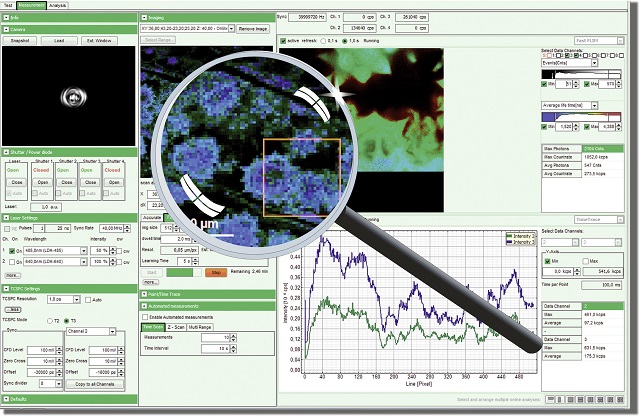
PicoQuant has released version 2.0 of its SymPhoTime 64 FLIM and FCS software package. New features include global analysis of FCS and TCSPC curve fitting, which especially improves cell measurements, as well as STED data acquisition and analysis procedures, e.g., gatedSTED, resolution estimation.
An extended TCSPC binning functionality permits faster analysis and binary export of FLIM images. In addition, a newly developed Fast Pattern Matching approach was implemented, which allows to separate two species by lifetime as well as absorption and emission spectra, thereby strongly refining FLIM image analysis.
Data acquisition functions have also been extended by a grid and tile mode. Grid mode permits automatic point measurements at numerous locations within the sample, whereas tile mode allows to acquire larger images (stitching).
An additional line profile analysis – Gaussian and Lorentzian – has been added that includes display and export of numerous image parameters, e.g., fluorescence lifetime, χ2. TIFF export of images and smoothing in nanometer steps for higher-quality Fast FLIM images have been implemented as well. The new version also supports the latest PicoHarp 300 software 3.0, and therefore now permits to adjust signal delays between the input signals via software with picosecond accuracy.
For the time-resolved confocal MicroTime 200, version 2.0 of the SymPhoTime 64 supports the wide-field fluorescence camera IDS uEye USB3 for straightforward selection of interesting sample regions and the new E-725 controller for scanning from Physik Instrumente.
The new software also has extended features for the combination of the MicroTime 200 with AFM (Atomic Force Microscopy), enabling a fascinating investigation into the structure, dynamics, and interactions of single molecules or their assemblies.
The versatile software is routinely delivered with all MicroTime and LSM Upgrade Kit systems and capable of acquiring FLIM, FRET, and FCS data using PicoQuant's photon counting modules PicoHarp 300, HydraHarp 400, and TimeHarp 260.
New features of the SymPhoTime 64 2.0 include global analysis of FCS and TCSPC curve fitting, which especially improves cell measurements, as well as STED data acquisition and analysis procedures (e.g. gated STED, resolution estimation)*. An extended TCSPC binning functionality permits faster analysis and binary export of FLIM images.
In addition, a newly developed Fast Pattern Matching approach was implemented, which allows to separate two species by lifetime as well as absorption and emission spectra, thereby strongly refining FLIM image analysis.Data acquisition functions have also be extended by a grid and tile mode.
Grid mode permits automatic point measurements at numerous locations within the sample, whereas tile mode allows to acquire larger images (stitching). An additional line profile analysis (Gaussian and Lorentzian) has been added that includes display and export of numerous image parameters (e.g. fluorescence lifetime, χ2).
TIFF export of images and smoothing in nanometer steps for higher-quality Fast FLIM images have been implemented as well. The new version also supports the latest PicoHarp 300 software (version 3.0), and therefore now permits to adjust signal delays between the input signals via software with picosecond accuracy.
About PicoQuant
PicoQuant GmbH is a research and development company in the field of optoelectronics. The company was founded in 1996 and is based in the science and technology park Berlin-Adlershof, Germany. The company is a worldwide leader in the field of single photon counting applications.
The product line includes pulsed diode lasers and LEDs, photon counting instrumentation, fluorescence lifetime spectrometers and time-resolved confocal microscopes. PicoQuant employs currently around 50 people. Since April 2008 Sales and Support in North America is handled by PicoQuant Photonics North America Inc.